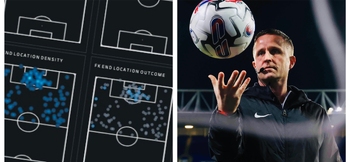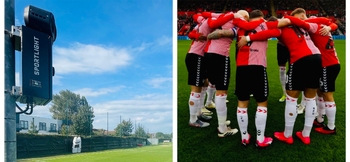Enda Barron: Getting creative with analysis at Ross County

Left: Ross County players Kayne Ramsay and Joseph Hungbo. Right: Enda Barron.
Written by Simon Austin — April 6, 2022
ENDA BARRON heads up the data and analysis department at Ross County.
Actually, perhaps I should rephrase that: Enda Barron IS the data and analysis department at Ross County.
“I do the databasing, the video analysis of opposition strengths and weaknesses, I film and analyse training, produce clips for feedback sessions with players, do scouting and recruitment… and the talent ID stuff,” he explains in an interview with TGG.
“There is a little bit of everything in there. I’m all things to all men.
It seems to be working though, because the unfashionable side from the Scottish Highlands are currently seventh in the SPFL and could win a place in the top six when the competition splits in half after this weekend.
After a dreadful start to the season, in which they lost seven and drew three of their first 10 games, County have the third best form in the league since the end of October, behind only Celtic and Rangers.
A section of the fanbase were unhappy when Malky Mackay was appointed manager last May, but it’s fair to say that most have now been won over. Mackay, the former Performance Director with the Scottish FA, brought Barron to the club with him last summer.
The duo had previously worked together at Cardiff City, during which time the Bluebirds won the Championship and reached the 2012 League Cup final against Liverpool.
County might only have a capacity of 6,500 at their Victoria Park ground and have spent most of their 93-year history in the Highland League, but they are holding their own against the big boys of Scottish football now.
When it comes to data and analysis, the watchwords for Barron are creativity and efficiency, because the club have a limited budget, resourcing and staff.
“What’s kept me in a job is variability and having multiple strings to my bow,” says Barron, who has worked for Mansfield Town, Bristol Rovers, Portsmouth, the Bahrain national team and Vancouver Whitecaps during a 20-year globetrotting career in pro football.
“I’ve never really specialised in one particular area of analysis, as a lot of people do now, but that has been good, because it allows you that little bit of flexibility.”
There is no such thing as a typical working week for him, but he does have set duties.

“The SPFL tends to be Saturday to Saturday if you’re not in Europe, so we can stretch meetings out during the week,” he says. “We do the opposition in-possession stuff on a Wednesday or Thursday; out of possession - so the areas in which we can hurt them - on a Thursday or Friday - and set plays on Friday as well.
“In terms of opposition analysis, I will be lucky to do two games, compiling the pluses and minuses, because you have to put your in-game and post-game hats on pretty quickly.”
Barron sometimes films and analyses training sessions, but again he has to be selective and creative with this.
“I don’t do it every day, because I am only one person, but we will bring it out (the camera) if we are focusing on patterns of play or match simulations to show space appreciation in the full-sided sessions.
“We film from the physio room window, because that looks out on one of the training pitches.”
Use of technology has to be carefully costed and fully justified.
“With a club of our size, we have to use everything as fully as we can,” he explains. “Everyone needs to know the technology is being used and is vindicated."

Left to right: Malky Mackay (manager), Don Cowie (assistant), Stuart Taylor (first team coach) and Enda Barron
One tool he uses extensively - and has done at three of his clubs now - is Tactic by RT Software. This is the same telestrator that's used by Villarreal, Seville, Brentford and the Ireland and Wales national teams.
“It’s a tool that gets inserted at all points, both pre and post-match,” Barron says. “And when you’re doing the recruitment stuff you want to highlight players for the manager using telestration too. The old way was time consuming but now it’s tick tick tick and off you go.
“We use it for all the opposition analysis and for our analysis of our own individual, unit and team performances.”
Video is now fundamental for players, he argues.
“The learning modality for footballers has changed so much. I remember we did a test to find out how the players liked to learn at Cardiff, more than 10 years ago. They were overwhelmingly kinaesthetic learners, which meant they wanted to go out onto the training pitch and walk things through.
“Now we are in the Playstation age and players are much more visual and comfortable with video for their learning and analysis. We tend to use the big screen in our video suite to do this, which is about 96 inches wide.
“In the team or unit meetings we highlight mistakes and are careful not to come across as too critical, because it’s a learning experience. It’s always important there’s buy-in from the players.”
Even most fans will be familiar with telestration - essentially drawing on video - because of its use on shows like Monday Night Football on Sky. The same techniques have become second nature to players, coaches and analysts within football clubs.
“I can go back to the late 2000s when Sky Sports were able to put on their highlights and arrows and clubs wanted to take that too,” Barron remembers. “The cost of it was astronomical at the time though and it could take hours to upload and animate the videos. It’s great that the graphic software has changed so much. The cost of it has gone down and the speed at which you can now do it is phenomenal.”
There are a range of drawing tools, but some he uses time and time again.
“The spotlight is one I like - the rotating circle they use on TV," Barron says. "The simple tracking one as well - and you can change the colours to that of the opposition, like green and white for Celtic, which is great. The tracking line for tracking runners is good, although a bit more time consuming.
“We use the big squares a lot, when we’re highlighting areas in which to exploit teams. And we like to highlight distances and there’s an easy way to do that. For example when we were doing our prep for the Celtic game (on March 19th) we looked at their match against Bodø/Glimt.
“Bodø’s gaps between the lines, both vertical and horizontal, were quite small and they were able to frustrate Celtic. It was something we were trying to adapt as well, to get our lads to play tighter, because Celtic can pull you out of position very quickly and pick you off.
“You get plenty of teams up here in Scotland that will want to defend the middle of the pitch and end up leaving their full backs very isolated, so it can be good to highlight the gap between the full back and centre half in particular. Being able to flick between an arrow and a line on Tactic is brilliant. They have multiple tools to tell multiple stories.”
“And any time I’ve asked them a question they’ve been quick to have an answer. I remember the first time I used Tactic I was on a coach going to a game at a former club and they were able to solve my query there and then over the phone.”
Ross County play Aberdeen on Saturday and after that the SPFL splits in half. It’s between them, Motherwell and Hibernian to take fifth and sixth spots and finish in the top half.
“We’re trucking along nicely,” admits Barron. “We had a bad start, with a Covid outbreak in pre-season and then a very tough first six games against last season’s top six, but we have found some good form.”
He’s now been working in pro sport for two decades, having started off by taking the Masters in Performance Analysis course at the University of Wales Institute in Cardiff. There were some other notable names of analysis on his course.
“There were only 10 in the class and we all got jobs out of it. There was Rhys Long, who is now Head of Performance Analysis and Insight for the Football Association, Lucy Rushton, the General Manager for DC United, and Garvan Stewart, who’s the Senior Analyst at Bournemouth. Brian Prestidge (now Director of Insights and Decision Technology at Manchester City) was in the year above."
The world of performance analysis has taken them all in different directions, and Barron’s own journey has ended up in the beautiful Scottish Highlands.
“Inverness is glorious," he says. "Dingwall, where we are, is at sea level, but you can see the snow-capped hills when you open your window. It’s a lovely part of the world.”
Professionally, he’s a one-man analysis department and could yet help Ross County qualify for a top-half competition in the SPFL against some of Scotland’s biggest names.
- This article was produced in partnership with Tactic by RT Software.













